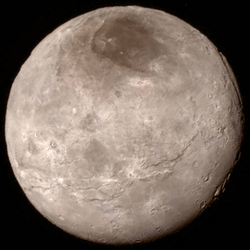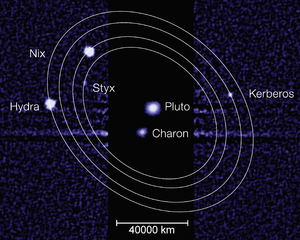Kharon (satelit)
 Kharon (Inggeris: Charon pengucapan: /ˈʃɛərən/ SHAIR-ən, atau /ˈkɛərən/ KAIR-ən seperti dalam bahasa Yunani: Χάρων), ditemukan tahun 1978, adalah sebuah satelit terbesar Pluto dan salah satu anggota planet katai ganda dengan Pluto sebagai anggota lainnya, bergantung pada definisi. Dengan penemuan dua bulan Pluto lainnya (Niks dan Hidra), Kharon kini disebut Pluto I. Misi wahana antariksa New Horizons dijadwalkan mengunjungi Kharon dan Pluto pada Juli 2015.
Kharon (Inggeris: Charon pengucapan: /ˈʃɛərən/ SHAIR-ən, atau /ˈkɛərən/ KAIR-ən seperti dalam bahasa Yunani: Χάρων), ditemukan tahun 1978, adalah sebuah satelit terbesar Pluto dan salah satu anggota planet katai ganda dengan Pluto sebagai anggota lainnya, bergantung pada definisi. Dengan penemuan dua bulan Pluto lainnya (Niks dan Hidra), Kharon kini disebut Pluto I. Misi wahana antariksa New Horizons dijadwalkan mengunjungi Kharon dan Pluto pada Juli 2015.
 Foto Kharon yang direkam oleh New Horizons pada 14 Juli 2015 | |
| Penemuan | |
|---|---|
| Ditemukan oleh | James W. Christy |
| Tanggal penemuan | 22 Juni 1978 |
| Penamaan | |
| Pelafalan | /ˈʃærən/ atau /ˈkɛərən/[note 1] |
Asal nama | Kharon |
| (134.340) Pluto I[1] | |
| Ciri-ciri orbit [3] | |
| Epos 2.452.600,5 | |
| 17.536±4 km ke barisenter sistem, 19.571±4 km ke pusat Pluto | |
| Eksentrisitas | 0,00[2] |
| 6,3872304±0,0000011 h (6 hari, 9 jam, 17 menit, 36,7 ± 0,1 detik) | |
Kecepatan orbit rata-rata | 0,21 km/detik[note 2] |
| Inklinasi | 0,001° (ke ekuator Pluto) 119,591°±0,014° (ke orbit Pluto) 112,783°±0,014° (ke ekliptika) |
| 223,046°±0,014° (ke ekuinoks vernal) | |
| Satelit dari | Pluto |
| Ciri-ciri fisik | |
Jari-jari rata-rata | 603,5±1,5 km[4] (0.095 Earths) |
| 4,58×106 km2 | |
| Volume | 9,027×108 km3 (0,0008 Bumi)[5] |
| Massa | (1,52±0,06)×1021 kg[3] (2,54×10−4 Bumi) (11,6% Pluto) |
Massa jenis rata-rata | 1,65±0,06 g/cm3[3] |
| 0,278 m/s2 | |
| 0,580 km/s 0.36 mi/detik | |
| Sinkronis | |
| 0? | |
| Albedo | 0,36 hingga 0,39 |
| Suhu | −220 °C (53 K) |
| 16,8[6] | |
| 1[7] | |
| 55 milli-arcsec[8] | |

Kharon ditemukan oleh astronom James Christy pada tanggal 22 Juni 1978, ketika ia memeriksa gambar Pluto yang diperbesar. Christy menyadari bahwa bagian kecil yang menonjol muncul pada waktu tertentu. Kharon awalnya disebut S/1978 P 1 Pada 24 Juni 1978, Christy mengusulkan nama Kharon.
Kharon memiliki diameter sebesar 1.207 km, sekitar setengah dari diameter Pluto, dengan luas permukaan sebesar 4.580.000 km². Tidak seperti Pluto yang dilapisi nitrogen dan es metana, permukaan Kharon didominasi oleh es dan tidak memiliki atmosfer.
Galeri
Lihat pula
Catatan
- ^ In US dictionary transcription, US dict: shăr′·ən, kār′·ən, the latter per the anglicized pronunciation of the bahasa Yunani: Χάρων.
- ^ Dihitung berdasarkan parameter lain.
Referensi
- ^ Jennifer Blue (2009-11-09). "Gazetteer of Planetary Nomenclature". IAU Working Group for Planetary System Nomenclature (WGPSN). Diakses tanggal 2010-02-24.
- ^ M. Buie; et al. (2012). "The Orbit of Charon is Circular". The Astronomical Journal. 144: 15. Bibcode:2012AJ....144...15B. doi:10.1088/0004-6256/144/1/15.
- ^ a b c
DOI:10.1086/504422 10.1086/504422
Rujukan ini akan diselesaikan secara otomatis dalam beberapa menit. Anda dapat melewati antrian atau membuat secara manual. a, i, e per JPL (site updated 2008 Aug 25) - ^ B. Sicardy; et al. (2006). "Charon's size and an upper limit on its atmosphere from a stellar occultation". Nature. 439 (7072): 52–4. Bibcode:2006Natur.439...52S. doi:10.1038/nature04351. PMID 16397493.
- ^ Volume bola dengan radius 603,5 km = 902.704.853,6 km3 / 1.083.207.317.374 km3 = 8,4×10−4 = 0,00084 Bumi
- ^ "Classic Satellites of the Solar System". Observatorio ARVAL. Diakses tanggal 2007-10-19.
- ^ David Jewitt (June 2008). "The 1000 km Scale KBOs". Institute for Astronomy (UH). Diakses tanggal 2008-06-13.
- ^ "Stellar occultation allows VLT to determine Charon's size and to put upper limit on its atmosphere". ESO 02/06 – Science Release. 2006-01-04. Diarsipkan dari versi asli tanggal 2006-01-18. Diakses tanggal 2007-10-19.
Pranala luar
- Charon Profile Diarsipkan 2014-10-08 di Wayback Machine. at NASA's Solar System Exploration site
- James W. Christy and Robert S. Harrington, "The satellite of Pluto," The Astronomical Journal 83 (1978) 1005
- Marc W. Buie, Phases of Charon as seen from Pluto, Lowell Observatory
- Buie, Surface of Charon and Pluto
- Hubble reveals new map of Pluto, BBC News, September 12, 2005
- IAU Circular No. 3241 describing the discovery
- Measuring the Size of a Small, Frost World Diarsipkan 2008-05-17 di Wayback Machine. (ESO press release January 2006)
- M. J. Person et al.: Charon’s Radius and Density from the Combined Data Sets of the 2005 July 11 Occultation (submitted to the Astronomical Journal, February 3, 2006)
- Cryovolcanism on Charon and other Kuiper Belt Objects Diarsipkan 2009-03-20 di Wayback Machine.
- New Horizons Camera Spots Pluto’s Largest Moon - July 10, 2013 Diarsipkan 2013-12-08 di Wayback Machine.